The change of seasons is always dazzling.
The tender green sprouts
that had been poking up through the frozen ground
have now turned deep green.
Summer is the season of growth.
All living things grow and prosper
by feeding on the energy of the sun.
Compared to spring,
leaves are now stronger,
but they stubbornly increase their mass,
holding a passion for life
in their tough leaves.
The summer menu at a mountain temple
is filled with natural foods
that help one endure the heat
and provide nutrition.
The wisdom of the monks and nuns
who embrace summer, even at its hottest,
is imparted to the seasonal menu.
At a mountain temple in summer,
one eats such food,
and one’s heart becomes more expansive.
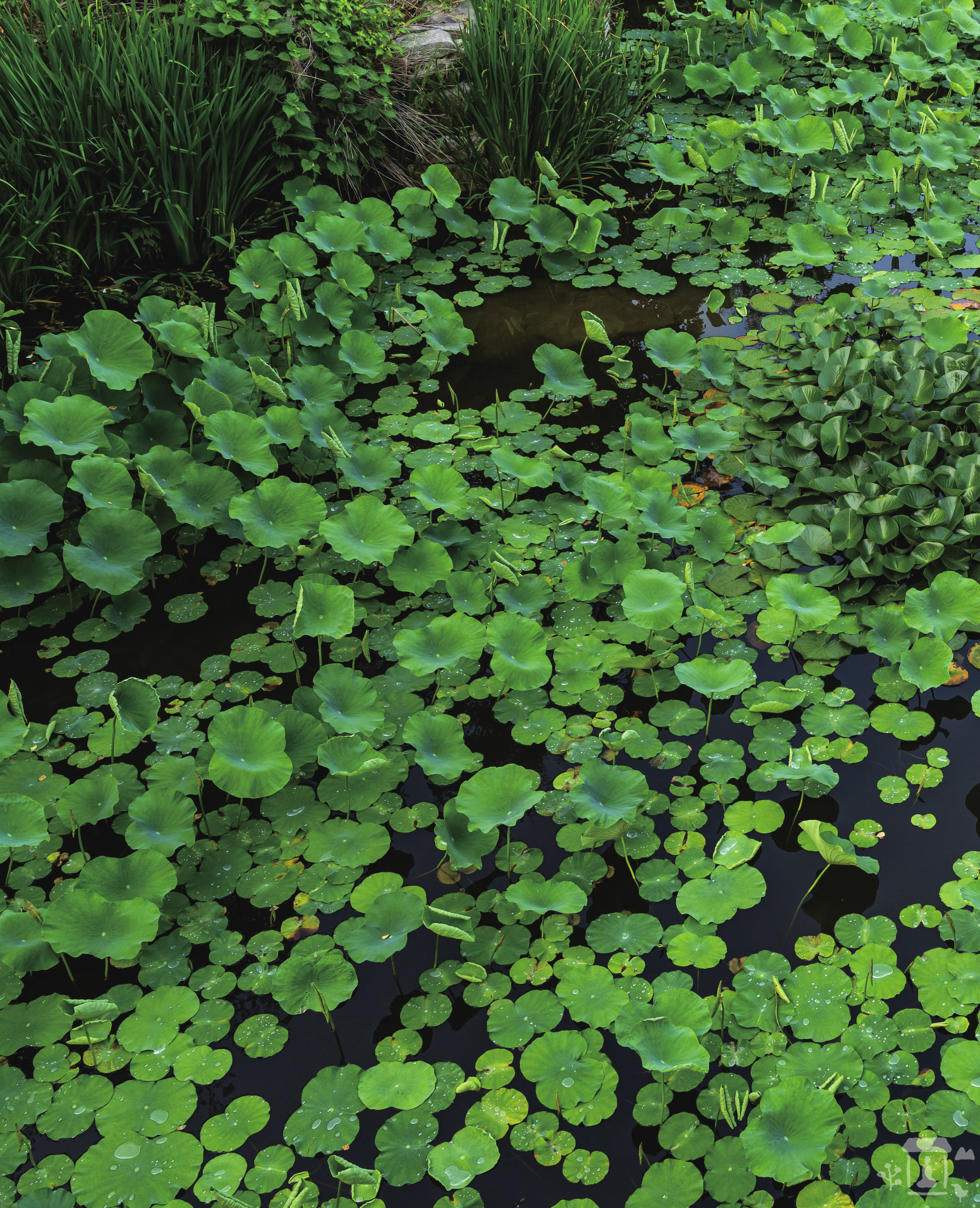
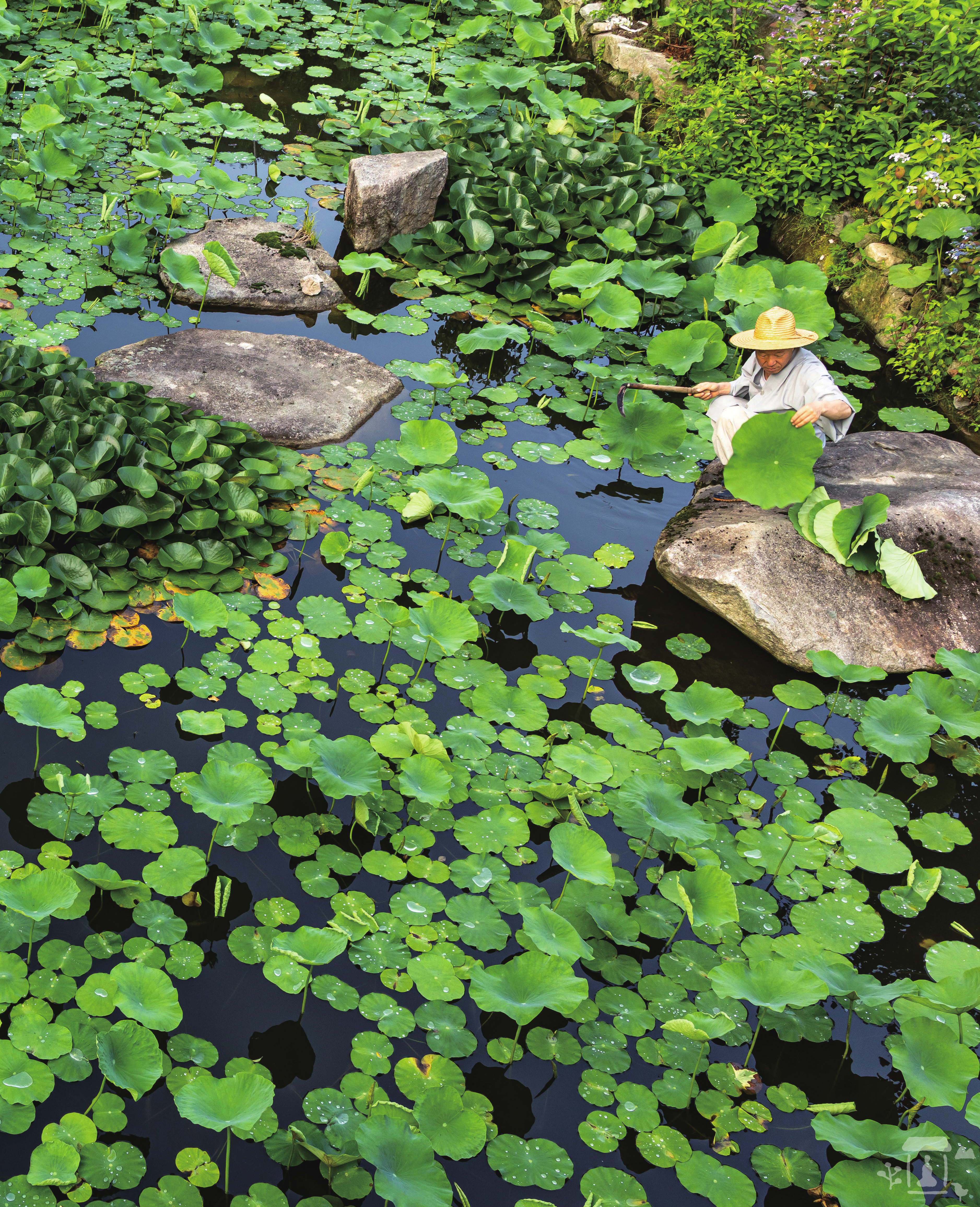
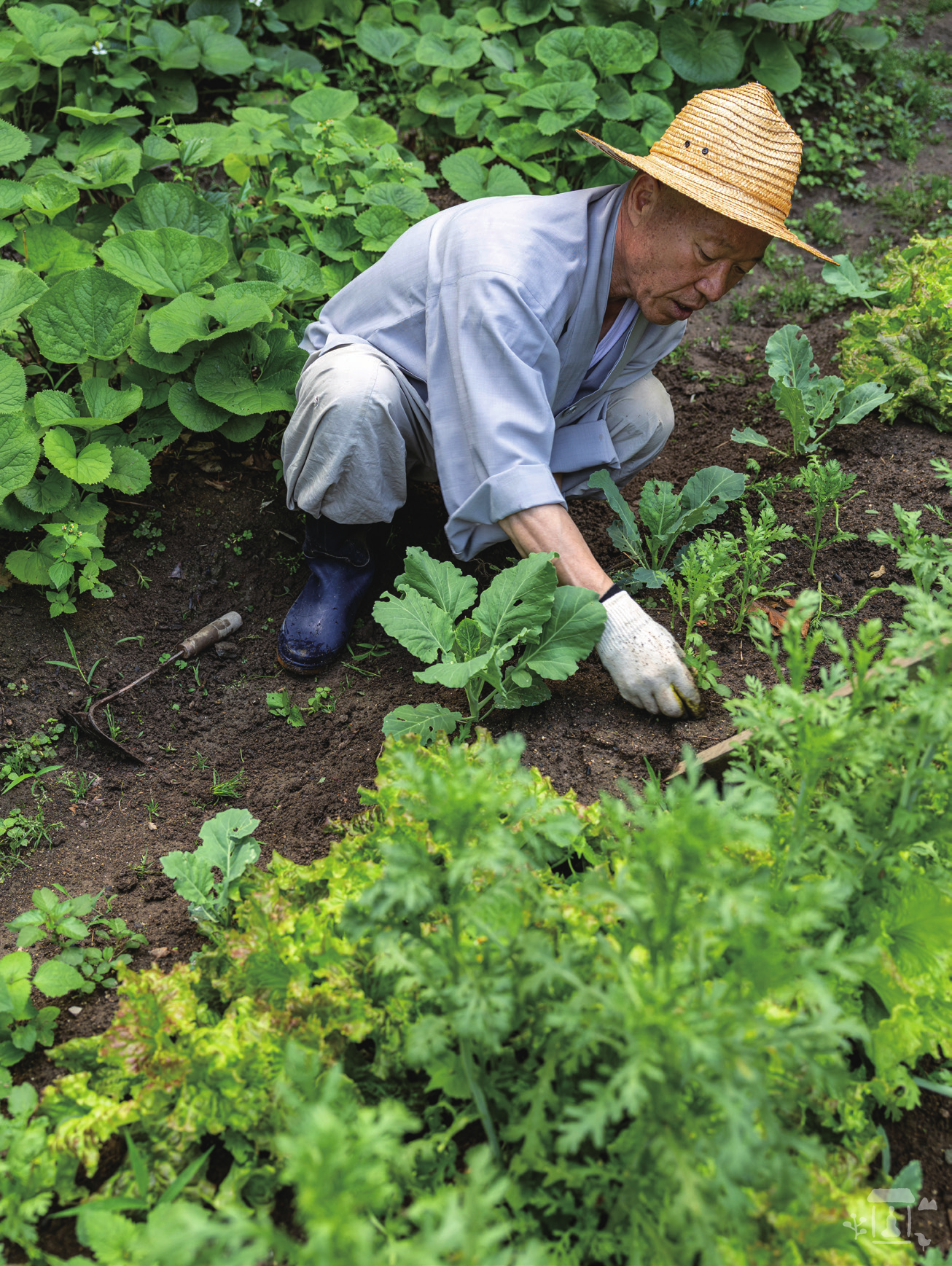
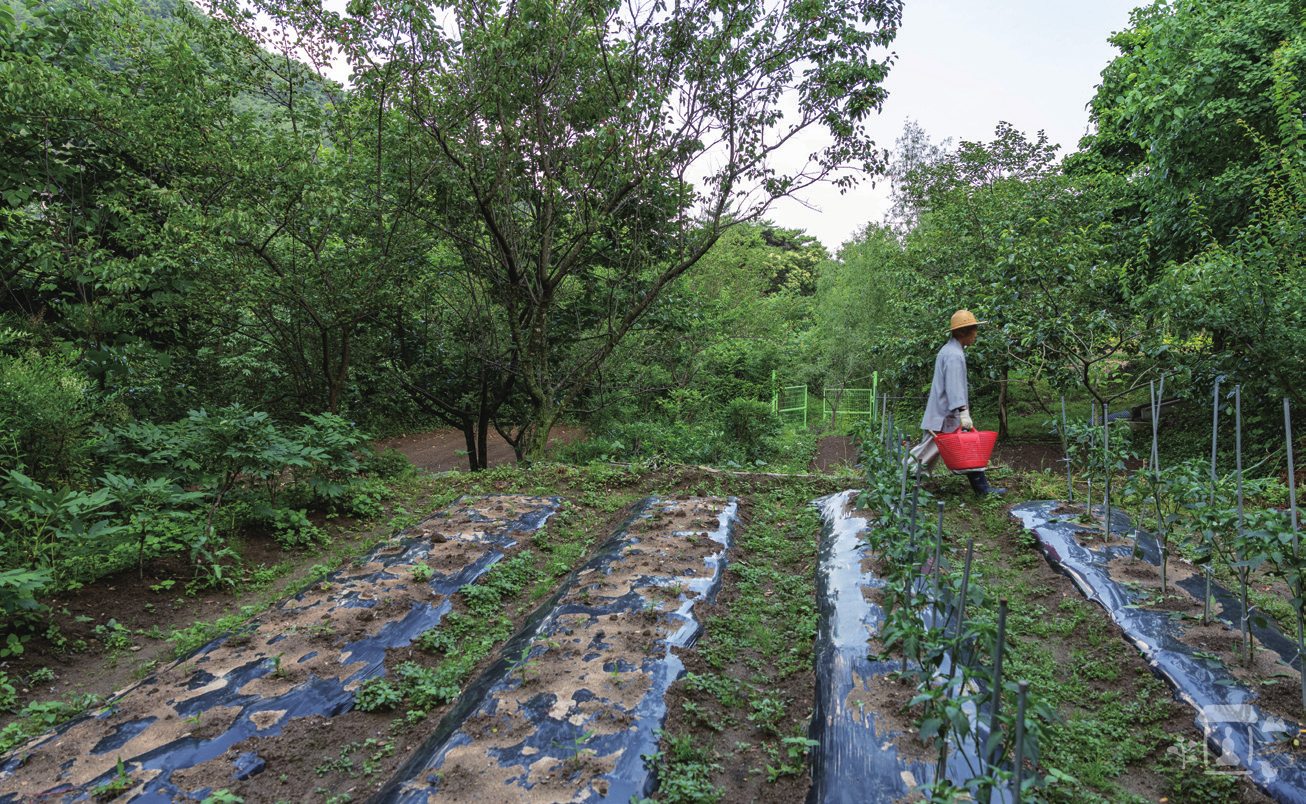
Affiliated with Tongdosa Temple, Hyangunam is a quiet hermitage where fragrant clouds seem to linger, just as its name implies. The one who welcomes me is Myeongcheon Seunim, who resides here alone. As he takes off his straw hat, I see his face beaded with sweat. Judging from the fact that he is wearing boots instead of the rubber shoes monks usually wear, I assume he has just finished working in the garden. In order to obtain food each day, he works the garden by hand every day. He is practicing a key teaching of Master Baizhang: “A day without work is a day without food.”
Summer’s blessing is obvious in the garden of Hyangunam, a garden where I see peppers, ginger, gomchwi (Fischer’s ragwort), kale, cucumbers, ssukgat (crown daisy chrysanthemum), leaf lettuce, etc. In addition to the garden, there is also an abundance of food growing naturally in the surrounding forest and fields.
There is a special story behind why Myeongcheon Seunim began to reside at Hyangunam. A long time ago, before entering the summer practice retreat, he came to pay his respects to an elderly monk who was then staying alone here. After serving the elderly monk lunch, he turned to leave and heard the old man say, “I think it would be helpful for me if you stay here.” Myeongcheon Seunim could not refuse the request, so he turned around and unpacked his belongings here instead of going to the Seon retreat. He still vividly remembers the rainwater dripping from the eaves that day. The elderly monk who convinced Myeongcheon Seunim to stay was Seongsu Seunim (1923―2012), a senior monk of the Jogye Order who had once served as the Order’s president.
Afterward, he served the elder and prepared him three meals a day. One day, the elder suggested that they should “live without going to the market,” so Myeongcheon Seunim started to cultivate a garden, a task he kept at for over 30 years. After the elder passed away 13 years ago, Myeongcheon Seunim continued to farm and practice alone at Hyangunam for many seasons. Although he never studied or received any guidance on temple food, his cooking skills are known far and wide.
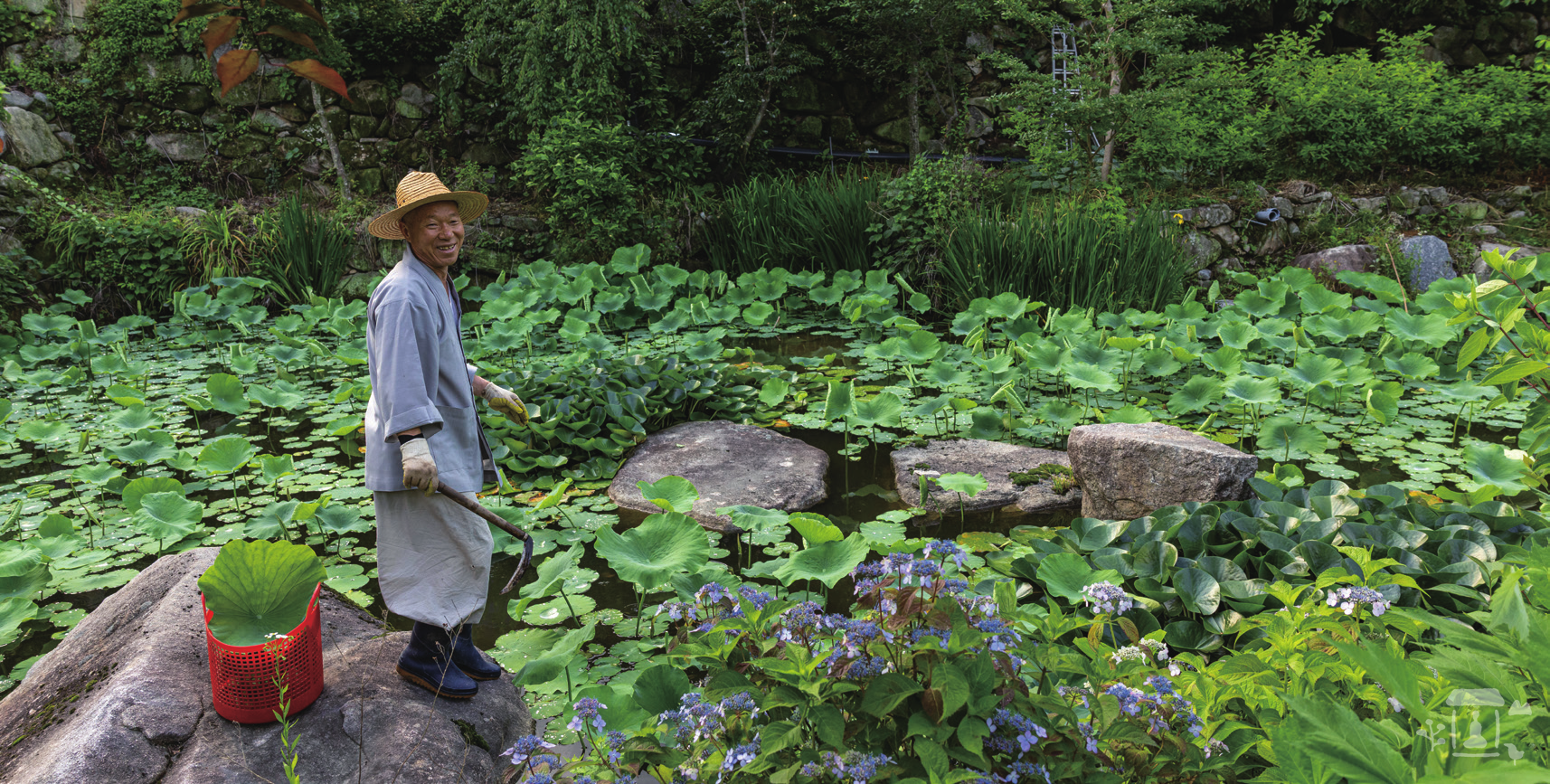
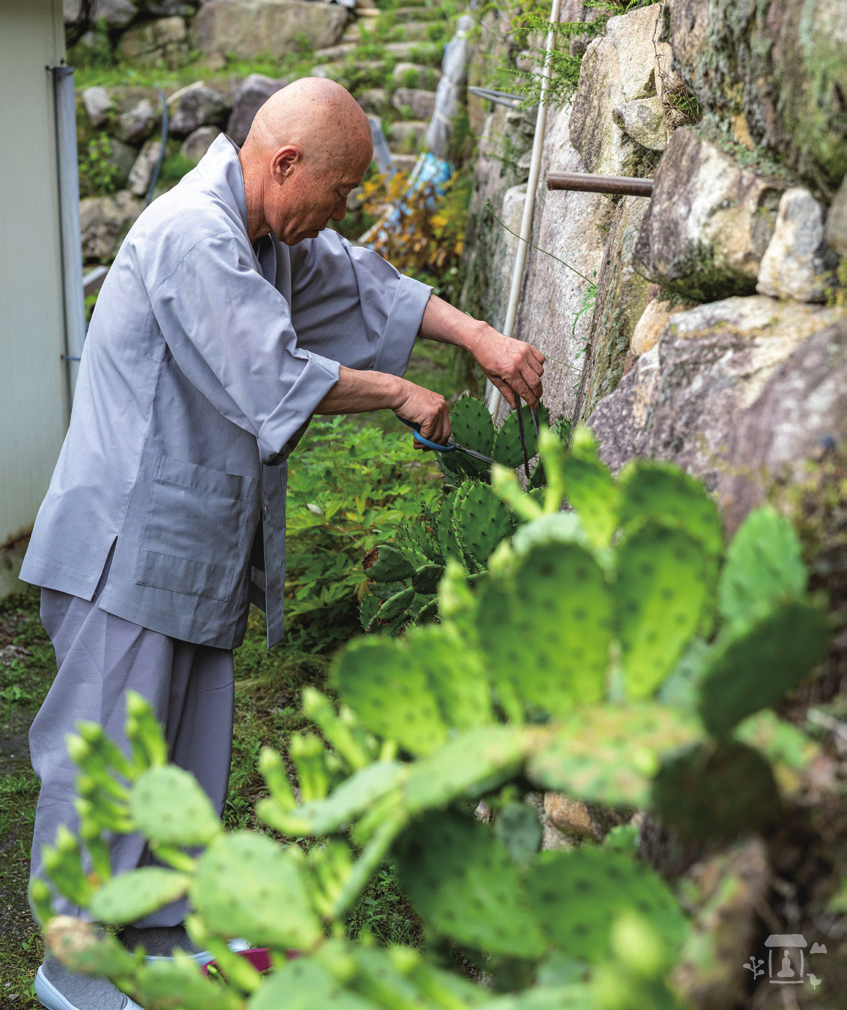
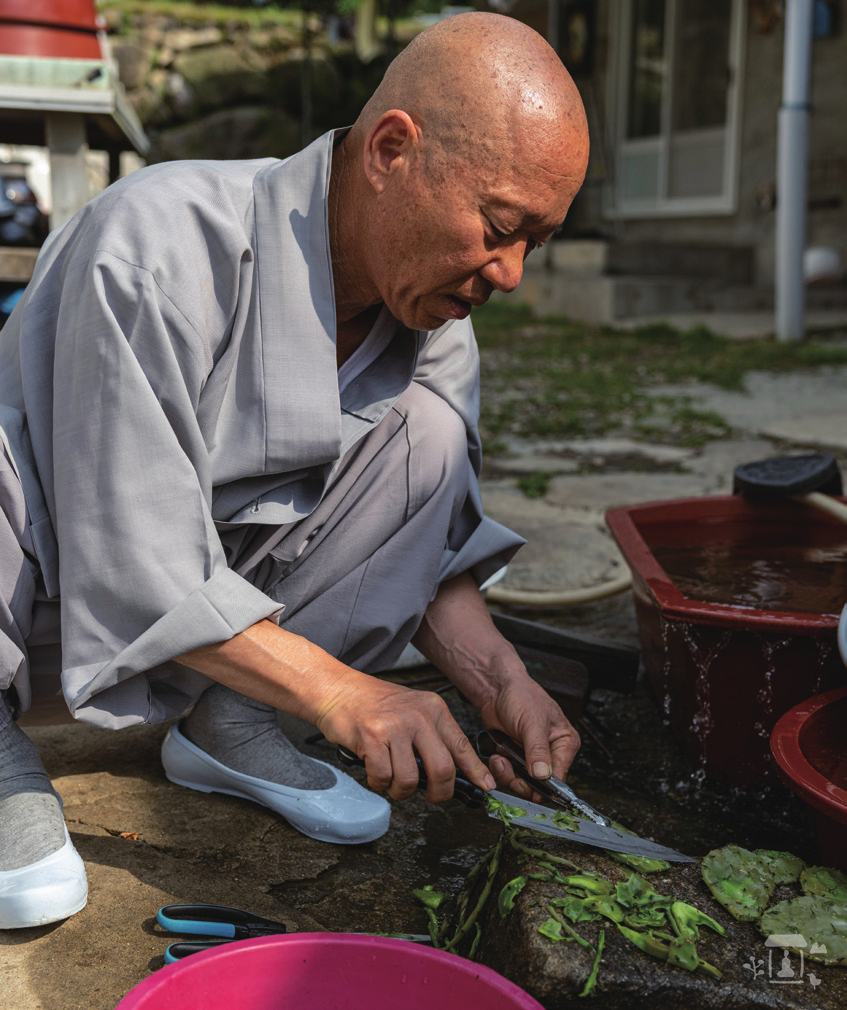
If it’s tough, make it tender, and if it’s tender, cook it properly. This is his secret, and it also aligns with the teachings of the Middle Path that the Buddha spoke of.
Grabbing a sickle and a sieve, Myeongcheon Seunim heads to the backyard and quickly cuts down some lush butterbur, which will be the first ingredient on today’s menu. Butterbur is usually in season from April to May, but it can be eaten even in the summer, even though the leaves are a little tougher than in spring. Its texture depends on how one cooks it. If it’s tough, make it tender, and if it’s tender, cook it properly. This is his secret, and it also aligns with the teachings of the Middle Path that the Buddha spoke of.
His hand now holds a pair of scissors instead of a sickle. The tools one uses need to change in accordance with the material being collected. Myeongcheon Seunim carefully cuts off an unfamiliar plant that has grown between the walls in front of the buddha hall. At first glance, it looks like a cactus because of the thorns. It is cheonnyeoncho, a native cactus and a variety of Eastern prickly pear that grows in Korea.
The last ingredient on today’s menu—following the butterbur and cheonnyeoncho—is lotus leaves. He picks both young lotus leaves that look relatively tender and curled up leaves not yet open. “Seongsu Seunim said that people can eat anything that animals eat,” says Myeongcheon Seunim.
One day, the elder asked if a dish could be made from the chestnut branches that goats eat, so Myeongcheon Seunim made water kimchi with chestnut branches together with Asian supplejack leaves and dandelions.
Especially on hot summer days like these, water kimchi is a must. Myeongcheon Seunim also made water kimchi with tall sseumbagwi (toothed ixeris) and Indian lettuce. He saved the broth he would use the next day to make water kimchi noodles in a bottle and kept it in the refrigerator, and the elder once drank it thinking it was a beverage
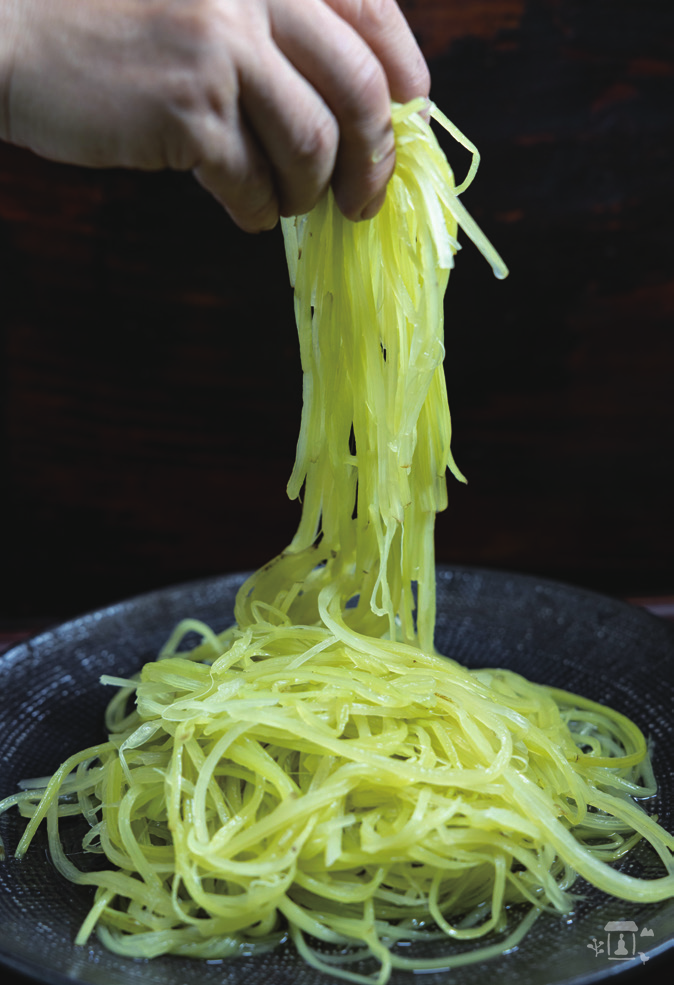
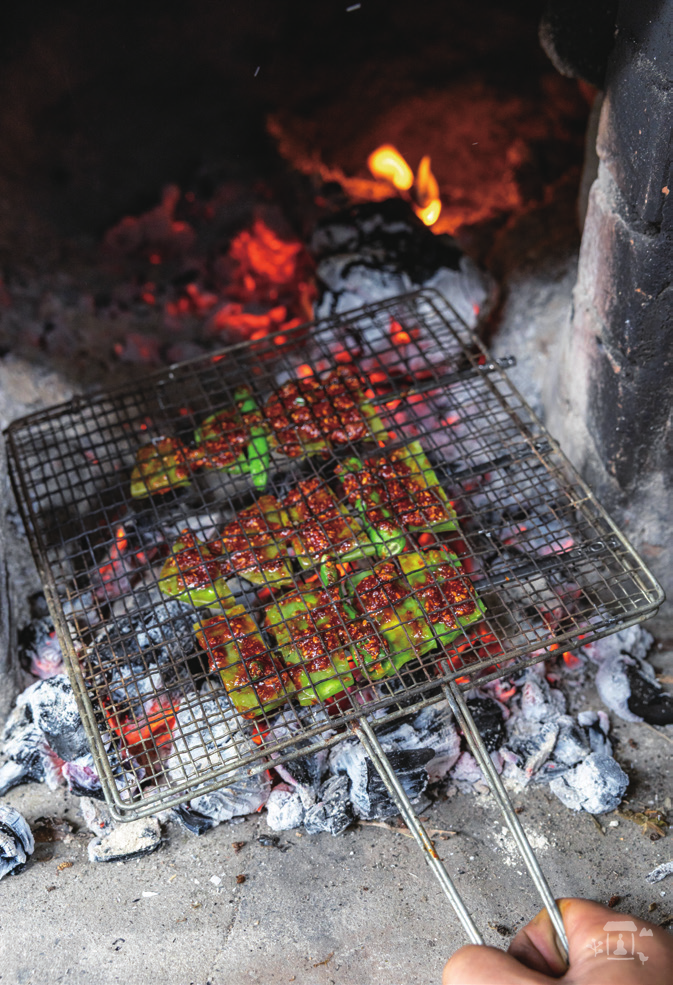
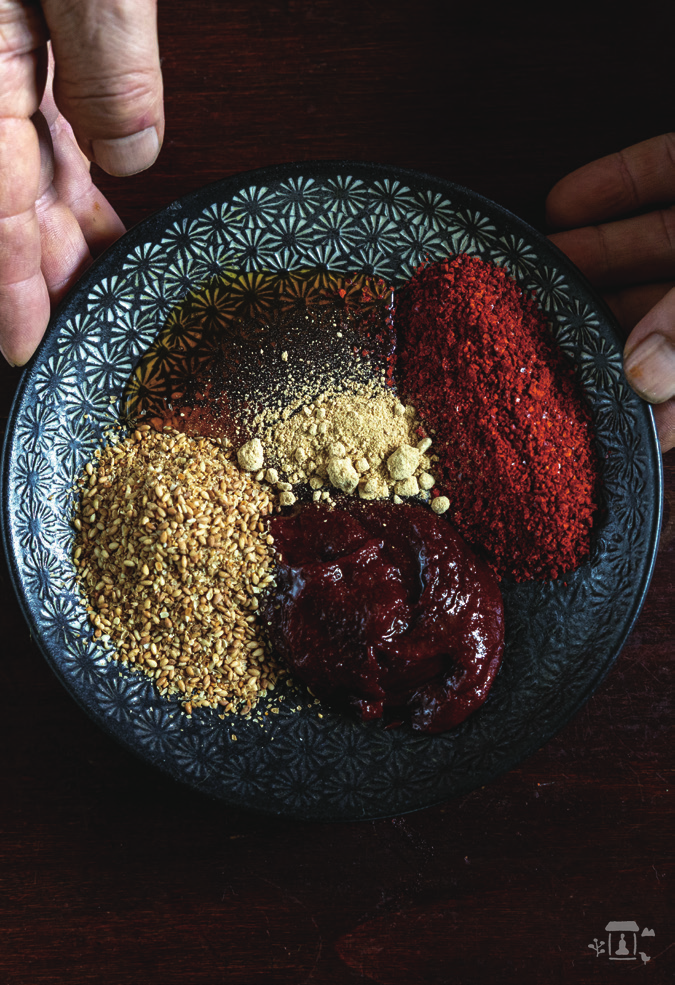
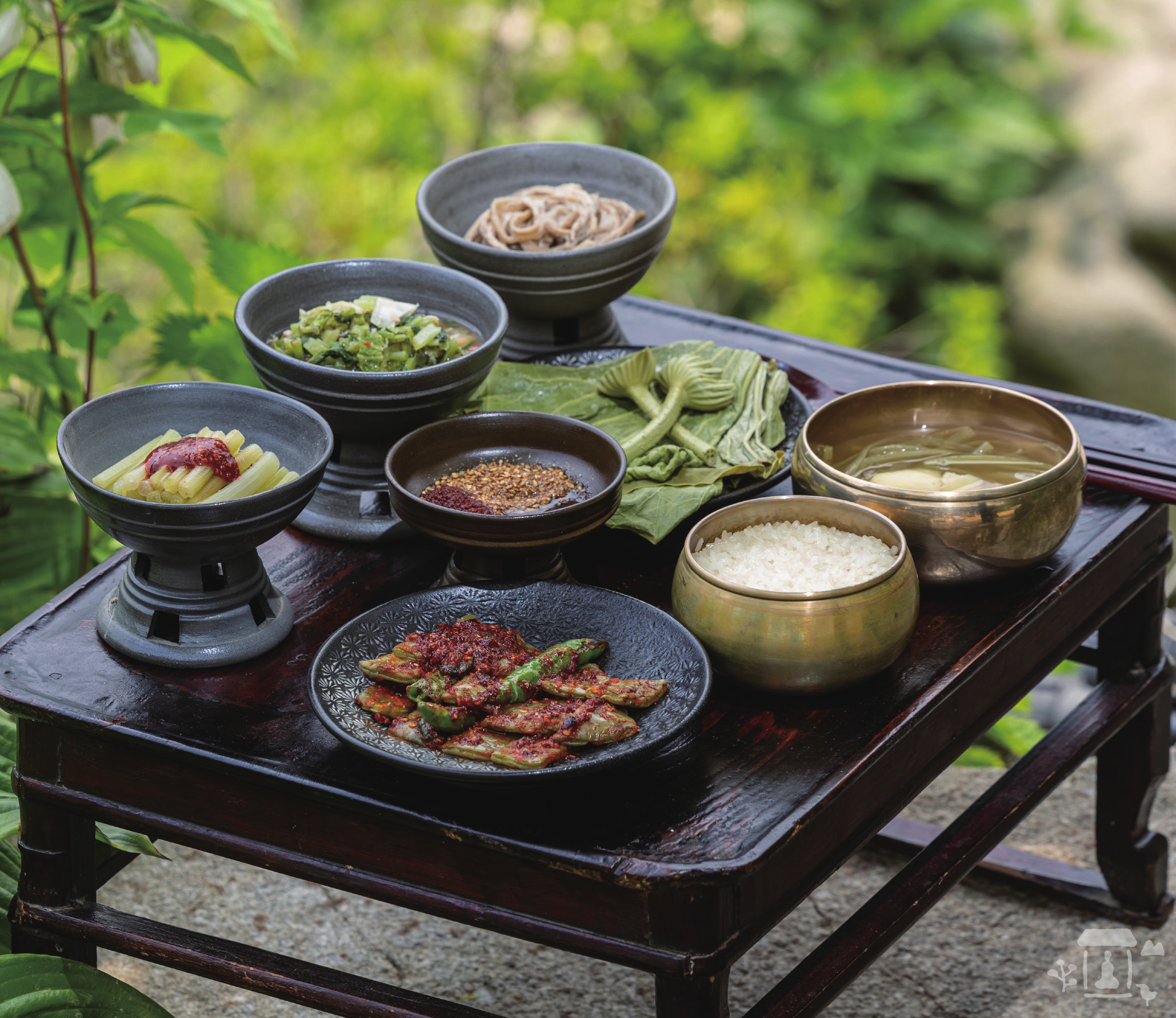
At the beginning of summer, the refreshing sound of the water flowing through the valley helps to dispel the heat. Hyangunam uses water from a mountain stream instead of tap water. Myeongcheon Seunim washes the collected ingredients in the stream water flowing from a hose. Having thorns, the cheonnyeoncho requires particularly careful handling. Lightly burning the cheonnyeoncho in the cauldron fire causes the thorns to fall off easily. He then boils the butterbur in a cauldron and peels off the skin.
Now that all the ingredients are ready, it’s time to start cooking. Today’s lunch menu consists of rice cooked in a cauldron, butterbur and potato soup, stir-fried dried butterbur, butterbur chohoe, grilled cheonnyeoncho, and steamed lotus leaves.
When he was at Tongdosa Temple, Myeongcheon Seunim was in charge of making soup. Back then, when he was living in a community, it was enough for him to do one job well, but when he came to live in a hermitage to serve the elder monk, he had to do everything by himself: cooking rice and soup, offering Buddhist ceremonies, cleaning, laundry, and farming. Perhaps because of that, his ability to cook three or four dishes at once is extraordinary.
For the butterbur and potato soup, he makes the broth with shiitake mushrooms and kelp, adds the soybean paste that he made himself, then adds butterbur and potatoes. He then simmers them until soft. When the potatoes are cooked, he sprinkles on some sesame seeds. For the stir-fried dried butterbur, he uses butterbur stems that he picked, boiled and dried in spring. First, he stir-fries the dried butterbur stems in sesame oil, then adds a bowl of the veggie stock, seasons with salt, and stir-fries until the water has almost boiled away. For the butterbur chohoe, he cuts the boiled butterbur stems into finger-sized pieces and adds chogochujang (sweet and sour red chili paste). For the steamed lotus leaves, he lays out a cotton cloth above a cauldron and steams them for about 10 minutes. He makes ssamjang with red pepper powder, sesame oil, soy sauce, and sesame seeds.
To make grilled cheonnyeoncho, he first makes a seasoning sauce by mixing together gochujang, red pepper powder, honey, sesame seeds, sesame oil, and ginger powder. The ginger powder is made at the hermitage by drying and crushing the ginger grown here. He skewers the cut cheonnyeoncho and green pepper, alternately placed on chopsticks. He spreads the seasoning sauce evenly on top, puts it on a grill, and roasts it on both sides in a cauldron furnace. I was most curious about what kind of dish could be made from cheonnyeoncho; obviously a tasty skewered dish. This was our summer meal at a mountain temple, made with seasonal ingredients from nature.
Myeongcheon Seunim says, “Around this time of year, the mountain behind us is full of wild strawberries. If I go up the mountain about 4km and pick wild strawberries for about 2 hours, I can fill a kettle with more than enough. And when I wash the wild strawberries and gently squeeze them in a cotton cloth and put the juice in a white cup, the color is so pretty. In the summer, I used to make wild strawberry juice for Seongsu Seunim. I also soaked kudzu flowers in sugar, made a drink from them and offered him a glass every day.”
Although there is no day without work in a mountain temple, there is a lot to do, especially in summer. In addition to weeding, you need to maintain the drainage before the rainy season arrives. When the elder was alive, starching his robes—made of hemp or ramie—was also Myeongcheon Seunim’s job. He also did not forget to sweep the dewdrops from the grass in the temple courtyard so the elder’s starched robes would not get wet
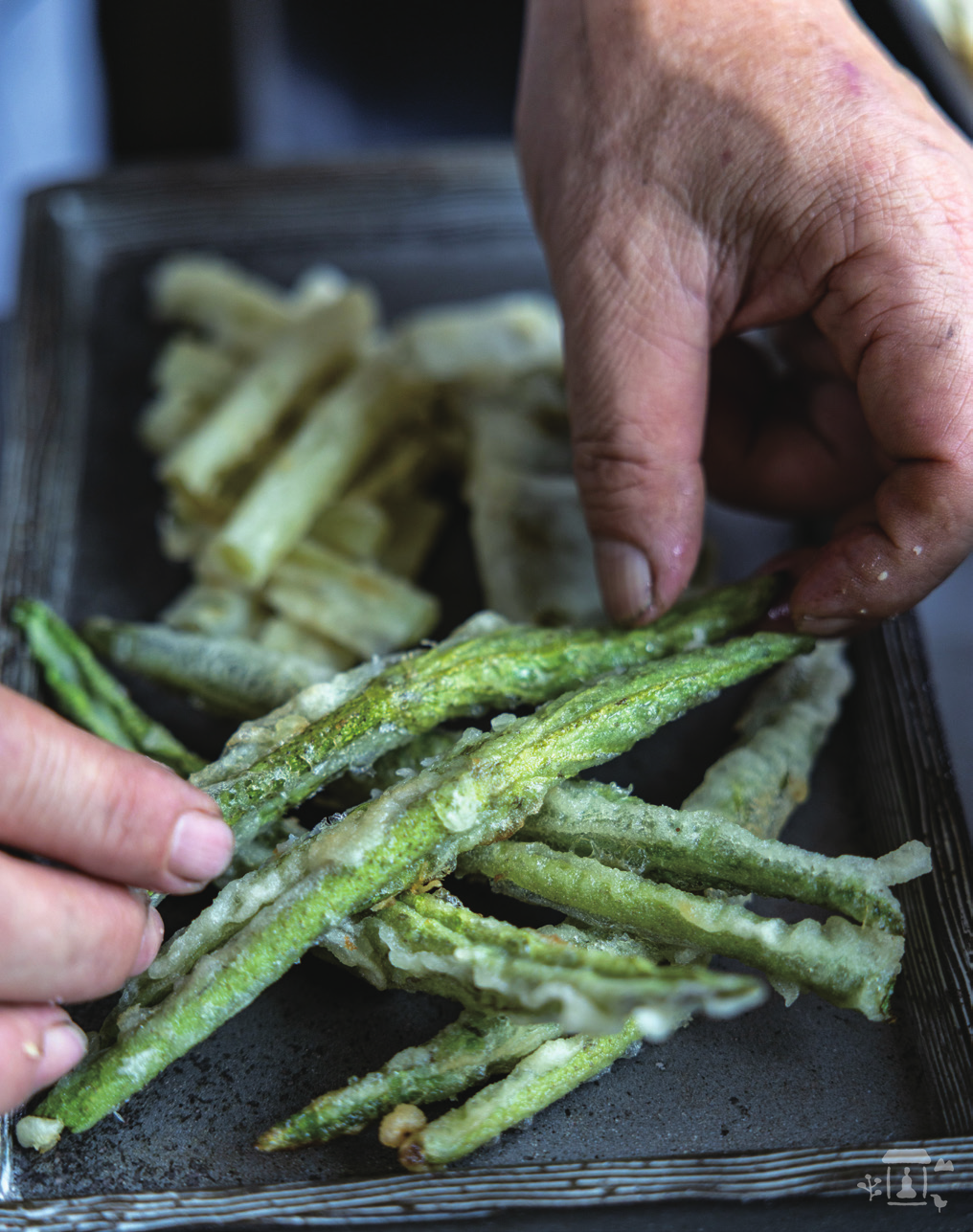
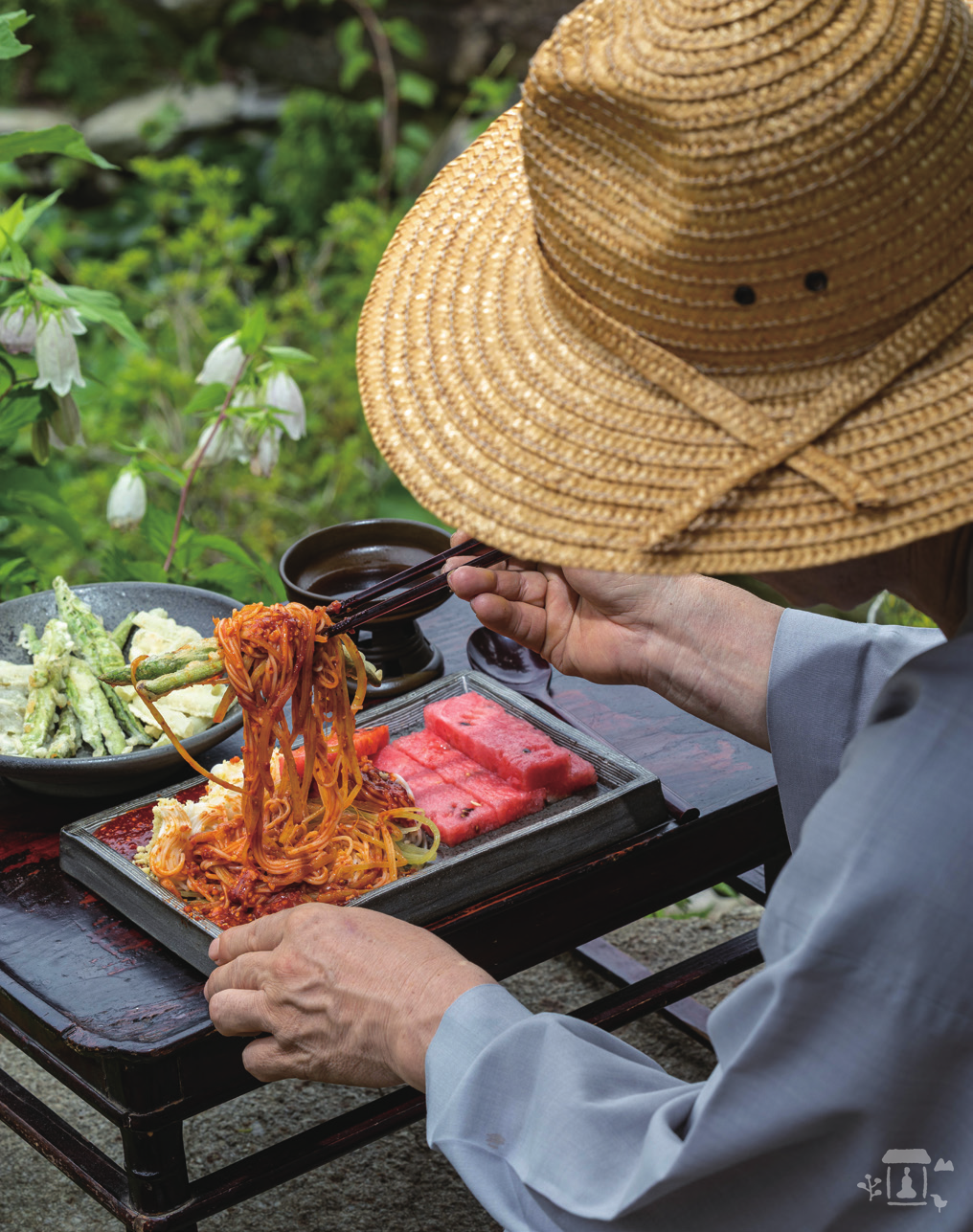
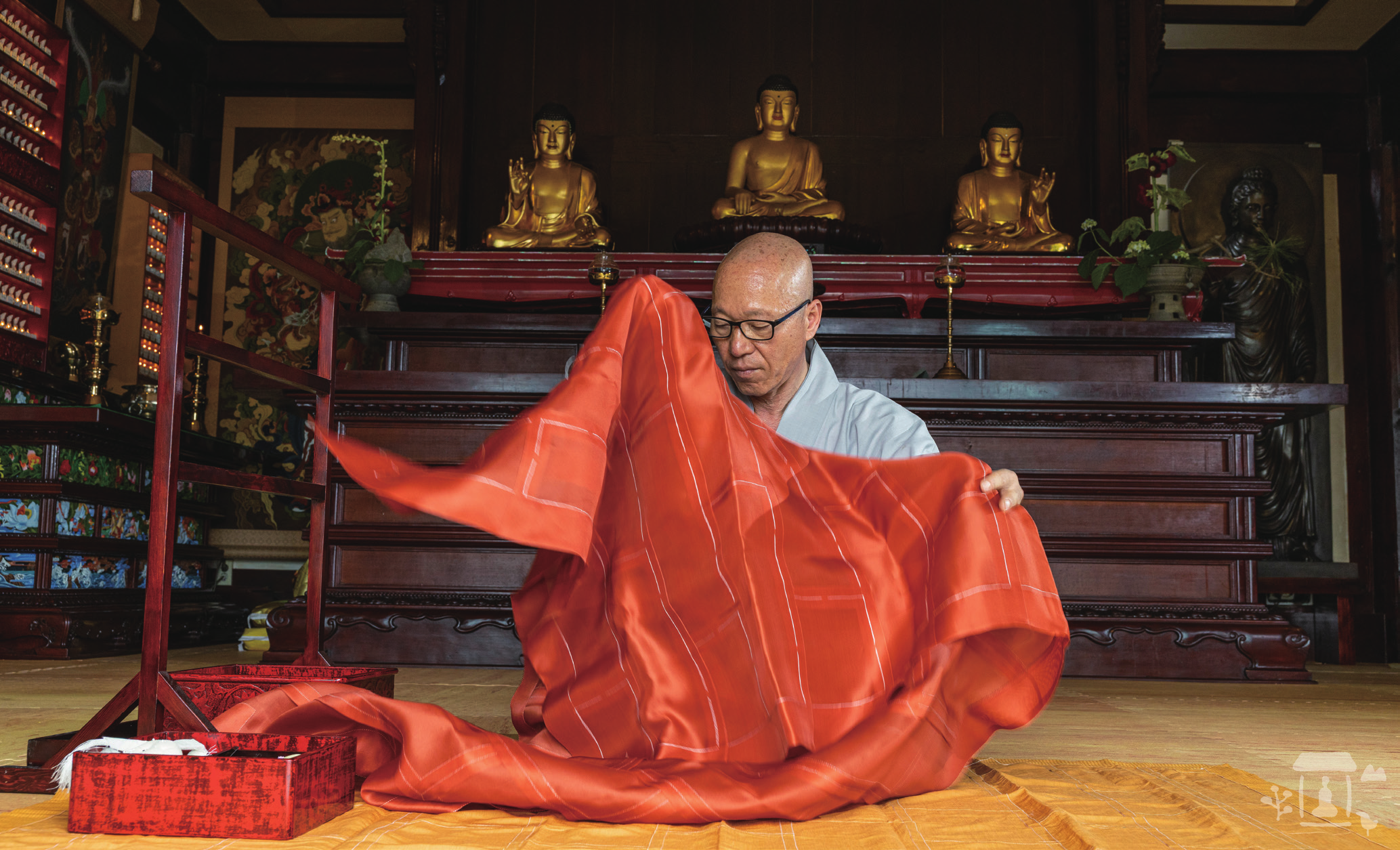
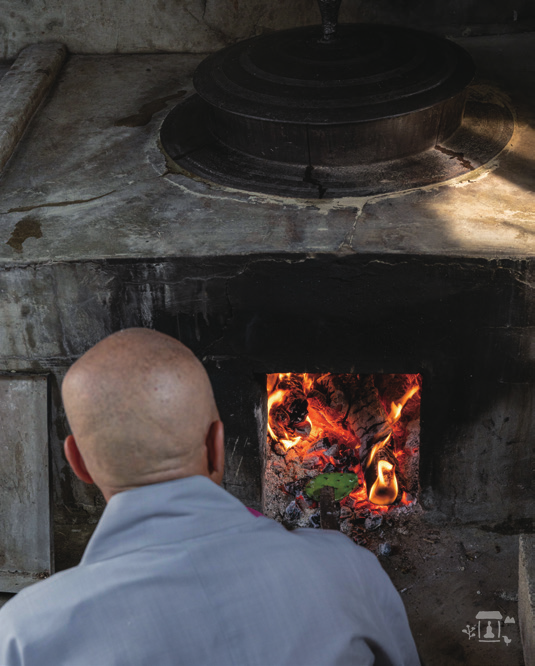
In fact, the relationship between Myeongcheon Seunim and the elderly Seongsu Seunim goes back even further. When Myeongcheon Seunim was in his second year of middle school, during winter vacation, he went to Gounsa Temple in Uiseong, the closest temple to his house, saying he wanted to become a monk. At that time, the abbot of Gounsa Temple was Seongsu Seunim, and he prepared dinner for this visiting middle school student who was shivering from the cold. Myeongcheon Seunim now remembers only two side dishes he ate that night: rice, soup made from dried radish greens coated in soybean powder, and soaked dried seaweed dipped in gochujang. He spent the night at the temple and returned home the next day. Later when he came of age, he entered monkhood at Tongdosa Temple.
Preparing three different meals a day—including gathering the ingredients and washing dishes—took up a considerable amount of time. There were times when he wondered if it’s right for a monk—who was walking the path to enlightenment—to spend too much time cooking and eating. But when the elder informed him that one cooks and eats three meals a day to avoid becoming indolent, Myeongcheon Seunim began to consider cooking a part of his Buddhist practice.
As the summer sun sets in the west, our evening meal has been prepared, consisting of butterbur bibim guksu (spicy cold noodles), fried veggies, and watermelon. The fried veggies are made by coating butterbur and lotus leaves in flour batter and frying them. It is a simple but hearty meal that helps one endure the heat and is nutritious as well.
Myeongcheon Seunim’s skills do not end with cooking. He has been restoring traditional gasa (formal monks’ robes) for 28 years, and he even won the grand prize for “Bokjeonui (Robes of the Field of Merit)” at the 24th Korean Buddhist Art Exhibition. He also recently gave a lecture on “the Origin and Evolution of Gasa” at the Seoul Museum of Crafts.
In the summer he is busy doing farm work, so he usually repairs gasa in the relatively leisurely winter. It takes a whole month to finish one gasa if he dedicates all his time to sewing. Now, since it is still the height of summer, he just does summer work. When I ask him a foolish question about the secret to surviving the heat of summer, he gives a wise answer:
According to him, the secret to surviving the summer at a mountain temple is to become one with the heat instead of resenting it.





